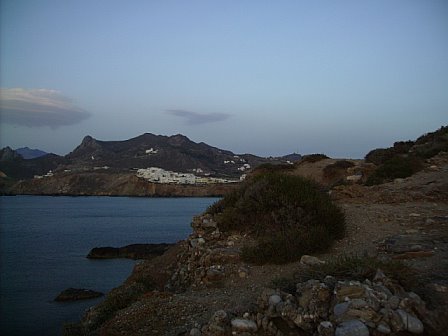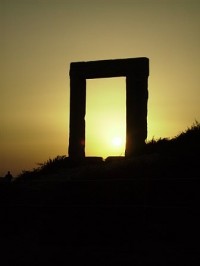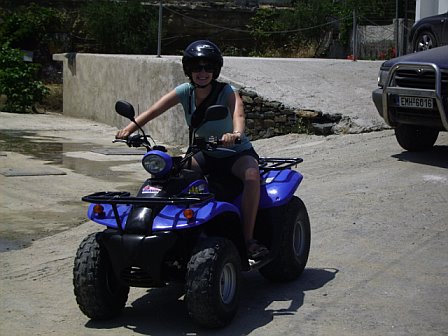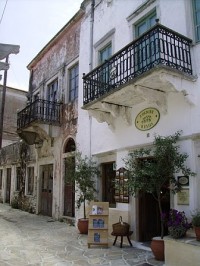We arrived at sunset. The Temple of Apollo, now just a remnant of the original, ancient edifice, clung to a rocky outcrop just north of the port. We walked out along the quay to see the stone pillars, backlit against the  pomegranate-red sunset. Others stood in small groups viewing the ruins. The only sound was of the waves cutting against the rocks.
pomegranate-red sunset. Others stood in small groups viewing the ruins. The only sound was of the waves cutting against the rocks.
This peaceful introduction to Naxos set the tone for our visit. Naxos, Greece has only recently discovered tourism and it still retains a sleepy atmosphere in keeping with its agricultural roots. The largest island in the Cyclades chain, Naxos has a hilly, green interior that is ringed by sandy beaches and small towns. We based ourselves in Chora Naxos and settled in for a wonderful week of leisurely exploration.
Lining the waterfront promenade of this busy town, are several open-air restaurants. And despite their touristy appeal, quite a few offer delicious, fresh seafood at a reasonable cost. Alleys lead back from the waterfront into the winding streets of the town’s Venetian quarter, the Kastro. In a full week of exploring this area, we could never quite map-out the intricate maze of narrow pedestrian streets. And it was this feature that contributed to the charm of stumbling upon hidden shops and plazas. We often found breakfast by discovering a bakery as it opened, and paying a mere euro for a delicious, hot spankopita off the tray.
One morning, we wandered into an inviting café that was tucked away somewhere up a hill. Its dark wood interior framed charming windows that opened to a cobblestone alley below. It was a neighborhood place, lovingly tended by the owners who invited us back that night for ouzo, appetizers, and traditional Greek music. This type of small-town friendliness is common on Naxos, many of whose residents are still farmers or fishermen.
 The towns people take great pride in the Naxos Castle and the adjacent Tower of Glezos. The castle, surounded by a pentagonal wall, long served as a fortification, and most recently was transformed into the Venetian Museum. Entrance to the museum, which sponsors classical music concerts in the summer months, is just inside the gates of the castle.
The towns people take great pride in the Naxos Castle and the adjacent Tower of Glezos. The castle, surounded by a pentagonal wall, long served as a fortification, and most recently was transformed into the Venetian Museum. Entrance to the museum, which sponsors classical music concerts in the summer months, is just inside the gates of the castle.
Chora’s main square is a bustling mix of tourist restaurants and bars. It’s the best place on the island to catch a soccer game, and is a lively mixture of visitors and locals. Chora Naxos also boasts some of the best Mexican food in Greece at the Picasso Mexican Bistro, an expat-owned restaurant that will satisfy any homesickness with a heaping plate of beans, sizzling peppers, and homemade tortillas.
To the south, the town gives way to Agios Georgios, a crowded but pretty stretch of beach, popular for swimming. We, however, preferred the narrow beaches of Plaka and Agia Anna, a few minutes further down the road, that were full of bars, snack shops, live music, and more youthful crowds.
 Having heard about Naxos’ lovely interior, we planed to rent motorcycles and explore. Unfortunately, we were provided with a less glamorous option: a 4-Wheeler. These squat, hardy machines top out at around 40 mph. We rented a bright purple creature and took off into the mountains. Despite the indignity of sleek Ducatis passing our silly little 4-Wheeler, we learned that independent transport is really the best way to see Naxos. We wound through gray olive groves, quaint farms, and tiny villages comprised of a few white, sun-baked homes. We refueled in the mountain village of Filoti, a cluster of buildings perched above a wide agricultural valley, and were delighted by the sight of Mt. Zeus, the island’s highest point, which cast its shadow over the valley.
Having heard about Naxos’ lovely interior, we planed to rent motorcycles and explore. Unfortunately, we were provided with a less glamorous option: a 4-Wheeler. These squat, hardy machines top out at around 40 mph. We rented a bright purple creature and took off into the mountains. Despite the indignity of sleek Ducatis passing our silly little 4-Wheeler, we learned that independent transport is really the best way to see Naxos. We wound through gray olive groves, quaint farms, and tiny villages comprised of a few white, sun-baked homes. We refueled in the mountain village of Filoti, a cluster of buildings perched above a wide agricultural valley, and were delighted by the sight of Mt. Zeus, the island’s highest point, which cast its shadow over the valley.
 In the town of Halki, the Vallindras Distillery makes citron, a liquor distilled from the local fruit of the same name. We toured the distillery, which has been in operation since the late 19th century and still uses its original methods and equipment. At the end of our complimentary tour, the guide poured a taste of the sweet, citrusy, emerald-green liquor. The traditional processes used to make citron, its homegrown ingredients, and the distillery’s new focus on tourism, perfectly embodied the changing character of this quiet island.
In the town of Halki, the Vallindras Distillery makes citron, a liquor distilled from the local fruit of the same name. We toured the distillery, which has been in operation since the late 19th century and still uses its original methods and equipment. At the end of our complimentary tour, the guide poured a taste of the sweet, citrusy, emerald-green liquor. The traditional processes used to make citron, its homegrown ingredients, and the distillery’s new focus on tourism, perfectly embodied the changing character of this quiet island.


Comments